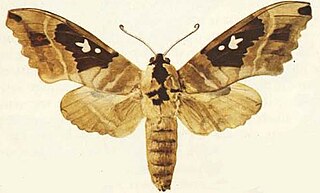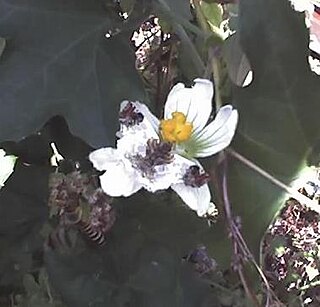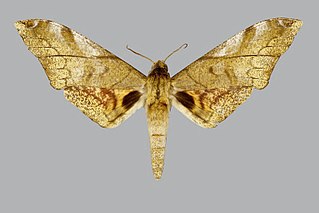
Polyptychus affinis is a moth of the family Sphingidae first described by Walter Rothschild and Karl Jordan in 1903. It is known at elevations up to 6,000 feet (1,800 m) in forests from Sierra Leone to the Congo, Uganda and western Kenya.

Macroglossum milvus is a moth of the family Sphingidae. It is known from Réunion and Mauritius.

Acanthosphinx is a monotypic moth genus in the family Sphingidae erected by Per Olof Christopher Aurivillius in 1891. Its only species, Acanthosphinx guessfeldti, the widow sphinx, was first described by Hermann Dewitz in 1879. It is known from forests from Sierra Leone to the Congo, Angola, Zambia, Malawi, Tanzania and Uganda.

Lophostethus is a genus of moths in the family Sphingidae first described by Arthur Gardiner Butler in 1876.

Euchloron is a monotypic moth genus of the family Sphingidae first described by Jean Baptiste Boisduval in 1875. Its only species, Euchloron megaera, the verdant hawk, is known from most of Africa and Yemen. It is a migratory species.

Netrobalane canopus, the buff-tipped skipper, is a butterfly of the family Hesperiidae. It is found in savannah in Africa, from South Africa to Kenya to Nigeria and southern Sudan.

Platysphinx constrigilis is a moth of the family Sphingidae first described by Francis Walker in 1869. It is known from Africa.

Basiothia medea, the small verdant hawk, is a moth of the family Sphingidae. It is common in open habitats throughout the Ethiopian Region, including Madagascar. It is however probably absent from the equatorial forest belt, except as a vagrant. The species is an active migrant.

Polyptychoides grayii, or Gray's polyptychus, is a moth of the family Sphingidae. It is known from eastern Africa, south to South Africa.

Pseudoclanis occidentalis is a moth of the family Sphingidae. It is known from Sierra Leone, Ivory Coast, Ghana, Cameroon, Gabon, the Central African Republic and Kenya.

Falcatula falcatus is a moth of the family Sphingidae. It is known from savanna and woodland from Zimbabwe to Malawi, Mozambique, Zambia, the Central African Republic and eastern Africa.

Lophostethus negus is a moth of the family Sphingidae. It is known from highland forests in Ethiopia.

Coelonia fulvinotata is a moth of the family Sphingidae first described by Arthur Gardiner Butler in 1875. It is known from most habitats throughout the Afrotropical realm, from the Gambia east to Ethiopia and south to northern South Africa and Madagascar.

Dovania poecila is a moth of the family Sphingidae. It is known from forests in Kenya, Uganda, Rwanda, Burundi, Tanzania and Malawi.

Cephonodes apus is a moth of the family Sphingidae. It is known from the Islands of Réunion and Mauritius.

Nephele densoi is a moth of the family Sphingidae. It is known from Madagascar and the Comoro Islands.

Nephele oenopion is a moth of the family Sphingidae. It is known from Africa.

Theretra capensis is a moth of the family Sphingidae. It is known from woodland and open habitats from the Cape to Zimbabwe, Zambia, Democratic Republic of the Congo, Malawi, Mozambique and East Africa.

Anaphe reticulata, commonly known as the reticulate bagnest or reticulate bagnet, is a moth of the family Notodontidae which is native to savannah in sub-Saharan Africa. It was described by Francis Walker in 1855. It has been recorded from Angola, Eritrea, Ivory Coast, Malawi, Mozambique and South Africa. In southern Africa it is described as common and widespread. Anaphe panda is similar in appearance and habits.


















